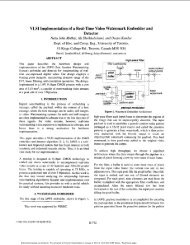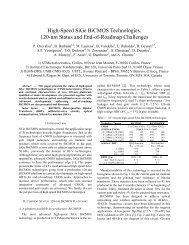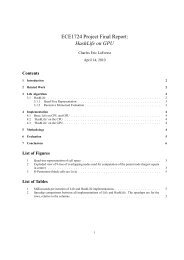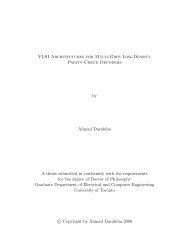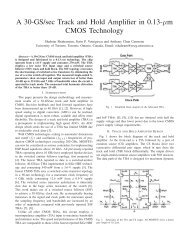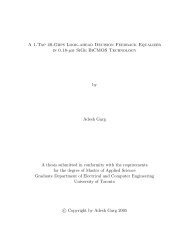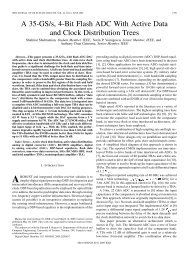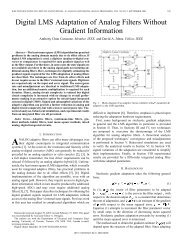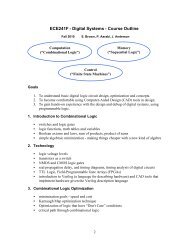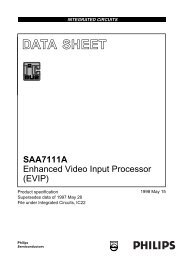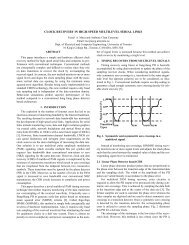ieee transactions on very large scale integration (vlsi) - Computer ...
ieee transactions on very large scale integration (vlsi) - Computer ...
ieee transactions on very large scale integration (vlsi) - Computer ...
Create successful ePaper yourself
Turn your PDF publications into a flip-book with our unique Google optimized e-Paper software.
YANG et al.: EXTRACTION ERROR MODELING AND AUTOMATED MODEL DEBUGGING IN HIGH-PERFORMANCE CUSTOM DESIGNS 775<br />
In the future, we plan to investigate additi<strong>on</strong>al types of extracti<strong>on</strong><br />
mismatches including errors that occur at the digital/analog<br />
tapping circuitry of custom designs. We will also extend the debugging<br />
methodology to handle multiple errors with multiple instantiati<strong>on</strong>s,<br />
and we will attempt to refine processes such as pathtrace,<br />
because their resoluti<strong>on</strong> seems to have a str<strong>on</strong>g effect <strong>on</strong> the<br />
overall debugging effort. Since the work in this paper deals with<br />
strictly pipelined circuit architectures, it is our intenti<strong>on</strong> to extend<br />
the debugging methodologies to operate <strong>on</strong> different n<strong>on</strong>pipelined<br />
circuitry as well as pipelines that include feedback.<br />
Finally, we plan to modify diagnosis and develop approximati<strong>on</strong><br />
heuristics that allow the approach to handle deeper pipelines<br />
with no state equivalence yet remain memory-/time-efficient.<br />
VI. CONCLUSION<br />
Logic extracti<strong>on</strong> is a mandatory reverse engineering process<br />
to generate tests in custom high-performance designs. This<br />
paper investigates discrepancies during extracti<strong>on</strong> and presents<br />
methodologies to improve test model generati<strong>on</strong>. Different<br />
classes of extracti<strong>on</strong> errors in the core and clocking circuitry of<br />
modern designs are presented, and their effects are analyzed in<br />
detail. A robust diagnosis algorithm for single extracti<strong>on</strong> errors<br />
with multiple instantiati<strong>on</strong>s in gate-level implementati<strong>on</strong>s with<br />
full, partial, and no state equivalence with the transistor-level<br />
schematic is also proposed. A comprehensive suite of experiments<br />
<strong>on</strong> circuits with architecture similar to the <strong>on</strong>e found<br />
in industry dem<strong>on</strong>strates its efficiency as it helps reduce the<br />
manual debugging effort by orders of magnitude. Investigating<br />
the nature of extracti<strong>on</strong> errors and debugging techniques for<br />
these errors help improve test model generati<strong>on</strong> and shorten<br />
test deli<strong>very</strong> time for high-performance low-power ICs.<br />
ACKNOWLEDGMENT<br />
The authors would like to acknowledge the technical c<strong>on</strong>tributi<strong>on</strong><br />
of J. Liu at early stages of this work. They would also<br />
like to thank the an<strong>on</strong>ymous reviewers of this paper and the reviewers<br />
in earlier c<strong>on</strong>ference versi<strong>on</strong>s who helped improve its<br />
presentati<strong>on</strong> and impact with their comments.<br />
REFERENCES<br />
[1] M. S. Abadir, J. Fergus<strong>on</strong>, and T. E. Kirkland, “Logic verificati<strong>on</strong><br />
via test generati<strong>on</strong>,” IEEE Trans. Comput.-Aided Des. Integr. Circuits<br />
Syst., vol. 7, no. 1, pp. 138–148, Jan. 1988.<br />
[2] H. Ando, Y. Yoshida, A. Inoue, I. Sugiyamal, T. Asakawa, K. Morita,<br />
T. Muta, T. Motokurumada, S. Okada, H. Yamashita, Y. Satsukawa,<br />
A. K<strong>on</strong>moto, R. Yamashita, and H. Sugiyama, “A 1.3-GHz fifth-generati<strong>on</strong><br />
sparc64 microprocessor,” IEEE J. Solid-State Circuits, vol. 38,<br />
no. 11, pp. 1896–1905, Nov. 2003.<br />
[3] D. Bearden, D. Caffo, P. Anders<strong>on</strong>, P. Rossbach, N. Iyengar, T. Petrsen,<br />
and J.-T. Yen, “A 780 MHz powerpc microprocessor with integrated l2<br />
cache,” in Proc. IEEE ISSCC, 2000, pp. 90–91.<br />
[4] D. T. Blaauw, D. G. Saab, P. Banerjee, and J. A. Abraham, “Functi<strong>on</strong>al<br />
abstracti<strong>on</strong> of logic gates for switch-level simulati<strong>on</strong>,” in Proc. IEEE<br />
Eur. C<strong>on</strong>f. Design Autom., 1991, pp. 329–333.<br />
[5] M. Boehner, “LOGEX—An automatic logic extractor from transistor<br />
to gate level for CMOS technology,” in Proc. Design Autom. C<strong>on</strong>f.,<br />
1988, pp. 517–521.<br />
[6] R. E. Bryant, “Extracti<strong>on</strong> of gate level models from transistor circuits<br />
by four-valued symbolic analysis,” in Proc. IEEE Int. C<strong>on</strong>f. Comput.-<br />
Aided Design, 1991, pp. 350–353.<br />
[7] D. Draper, M. Crowley, J. Holst, G. Favor, A. Schoy, J. trull, A. Ben-<br />
Meir, R. Khanna, D. Wendell, R. Krishna, J. Nolan, D. Mallick, H.<br />
Partovi, M. Roberts, M. Johns<strong>on</strong>, and T. Lee, “Circuit techniques in a<br />
266-MHz MMX-enabled processor,” IEEE J. Solid-State Circuits, vol.<br />
32, no. 11, pp. 1650–1664, Nov. 1997.<br />
[8] M. Gowan, L. Biro, and D. Jacks<strong>on</strong>, “Power c<strong>on</strong>siderati<strong>on</strong>s in the design<br />
of the alpha 21264 microprocessor,” in Proc. IEEE/ACM Design<br />
Autom. C<strong>on</strong>f., 1998, pp. 726–731.<br />
[9] N. Jha and S. Gupta, Testing of Digital Systems. Cambridge, U.K.:<br />
Cambridge Univ. Press, 2003.<br />
[10] T. Kostelijk and B. D. Loore, “Automatic verificati<strong>on</strong> of library-based<br />
IC designs,” IEEE J. Solid-State Circuits, vol. 26, no. 3, pp. 394–403,<br />
Mar. 1991.<br />
[11] N. Kurd, J. Barkatullah, R. Diz<strong>on</strong>, and T. Fletcher, “A multigigahertz<br />
clocking scheme for the Pentium microprocessor,” IEEE J. Solid-State<br />
Circuits, vol. 36, no. 11, pp. 1647–1653, Nov. 2001.<br />
[12] M. Kusko, B. Robbins, T. Snethen, P. S<strong>on</strong>g, T. Foote, and W. Huott,<br />
“Microprocessor test and test tool methodology for the 500 MHz IBM<br />
S/390 G5 chip,” in Proc. IEEE Int. Test C<strong>on</strong>f., 1998, pp. 717–726.<br />
[13] S. Kundu, “Gatemaker: A transistor to gate level model extracti<strong>on</strong> for<br />
simulati<strong>on</strong>, automatic test pattern generati<strong>on</strong> and verificati<strong>on</strong>,” in Proc.<br />
IEEE Int. Test C<strong>on</strong>f., 1998, pp. 372–381.<br />
[14] J. B. Liu and A. Veneris, “Incremental diagnosis,” IEEE Trans.<br />
Comput.-Aided Design Integr. Circuits Syst., vol. 24, no. 2, pp.<br />
240–251, Feb. 2005.<br />
[15] J. M. Rabaey, Digital Integrated Circuits: A Design Perspective.<br />
Upper Saddle River, NJ: Prentice-Hall, 1996.<br />
[16] Needs Document in Test and Testability (Area 6) Semic<strong>on</strong>ductor Research<br />
Corporati<strong>on</strong>, 2003 [Online]. Available: http://www.src.org/fr/<br />
test_call_03.asp<br />
[17] T. McDougall, A. Parashkevov, S. Jolly, J. Zhu, J. Zeng, C. Pyr<strong>on</strong>, and<br />
M. S. Abadir, “An automated method for test model generati<strong>on</strong> from<br />
switch level circuit,” in Proc. IEEE Asian-South Pacific Design Autom.<br />
C<strong>on</strong>f., 2003, pp. 769–774.<br />
[18] A. Veneris and I. N. Hajj, “Design error diagnosis and correcti<strong>on</strong> via<br />
test vector simulati<strong>on</strong>,” IEEE Trans. Comput.-Aided Design Integr. Circuits<br />
Syst., vol. 18, no. 12, pp. 1803–1816, Dec. 1999.<br />
[19] A. Smith, A. Veneris, M. F. Ali, and A. Viglas, “Fault diagnosis and<br />
logic debugging using Boolean satisfiability,” IEEE Trans. Comput.-<br />
Aided Design Integr. Circuits Syst., vol. 24, no. 10, pp. 1606–1621,<br />
Oct. 2005.<br />
[20] S. Venkataraman and W. K. Fuchs, “A deductive technique for diagnosis<br />
of bridging faults,” in Proc. IEEE Int. C<strong>on</strong>f. Comput.-Aided Design,<br />
1997, pp. 562–567.<br />
[21] Y. Yang, J. Liu, P. Thadikaran, and A. Veneris, “Extracti<strong>on</strong> error diagnosis<br />
and correcti<strong>on</strong> in high-performance designs,” in Proc. IEEE Int.<br />
Test C<strong>on</strong>f., 2003, pp. 423–430.<br />
[22] Y. Yang, A. Veneris, P. Thadikaran, nd, and S. Venkataraman, “Extracti<strong>on</strong><br />
error modeling and automated model debugging in high-performance<br />
low power custom designs,” in Proc. IEEE Design Test Europe,<br />
2005, pp. 996–1001.<br />
Yu-Shen Yang (S’02) received the B.A.Sc. degree<br />
(with h<strong>on</strong>ors) and the M.A.Sc. degree from the University<br />
of Tor<strong>on</strong>to, Tor<strong>on</strong>to, ON, Canada, in 2002 and<br />
2004, respectively, both in computer engineering. He<br />
is currently working toward the Ph.D. degree in computer<br />
engineering at the University of Tor<strong>on</strong>to.<br />
His research interests include VLSI circuit diagnosis<br />
and correcti<strong>on</strong>, design resynthesis, and design<br />
rewiring.<br />
Andreas Veneris (S’96–M’99–SM’05) was born<br />
in Athens, Greece. He received the Diploma in<br />
computer engineering and informatics from the<br />
University of Patras, Patras, Greece, in 1991, the<br />
M.S. degree in computer science from the University<br />
of Southern California, Los Angeles, in 1992, and<br />
the Ph.D. degree in computer science from the<br />
University of Illinois at Urbana-Champaign (UIUC),<br />
Urbana, 1998.<br />
He was a Vsiting Faculty Member with UIUC from<br />
1998 to 1999. In 1999, he joined the University of<br />
Tor<strong>on</strong>to, Tor<strong>on</strong>to, ON, Canada, where he is currently an Associate Professor,<br />
cross-appointed with the Department of Electrical and <strong>Computer</strong> Engineering<br />
and the Department of <strong>Computer</strong> Science. His research interests include CAD<br />
for synthesis, diagnosis, and verificati<strong>on</strong> of digital circuits and systems, data<br />
structures, and combinatorics. He is the coauthor of <strong>on</strong>e book.<br />
Dr. Veneris is a member of the the Associati<strong>on</strong> for Computing Machinery,<br />
AAAS, the Technical Chamber of Greece, and the Planetary Society. He was<br />
corecipient of a Best Paper Award at ASP-DAC’01.



